Coseismic Deformation Field Extraction and Fault Slip Inversion of the 2021 Yangbi MW 6.1 Earthquake, Yunnan Province, Based on Time-Series InSAR
Abstract
:1. Introduction
2. Tectonic Background
3. Materials and Methods
3.1. Time-Series InSAR Processing Method for Coseismic Deformation Field Extraction
3.2. Inversion of Fault Geometry Parameters and Slip Distribution
4. Results
4.1. InSAR Coseismic Deformation Field
4.2. Fault Geometry Parameters
4.3. Fault Slip Distribution
5. Discussion
5.1. Validation of Methods Using Synthetic Data
5.2. Advantages of Time-Series InSAR Processing Method for Coseismic Deformation Extraction
6. Conclusions
Author Contributions
Funding
Institutional Review Board Statement
Informed Consent Statement
Data Availability Statement
Acknowledgments
Conflicts of Interest
References
- Massonnet, D.; Rossi, M.; Carmona, C.; Adragna, F.; Peltzer, G.; Feigl, K.; Rabaute, T. The displacement field of the Landers earthquake mapped by radar interferometry. Nature 1993, 364, 138–142. [Google Scholar] [CrossRef]
- Fialko, Y.; Sandwell, D.; Simons, M.; Rosen, P. Three-dimensional deformation caused by the Bam, Iran, earthquake and the origin of shallow slip deficit. Nature 2005, 435, 295–299. [Google Scholar] [CrossRef]
- Peltzer, G.; Rosen, P. Surface Displacement of the 17 May 1993 Eureka Valley, California, Earthquake Observed by SAR Interferometry. Science 1995, 268, 1333–1336. [Google Scholar] [CrossRef]
- Ferretti, A.; Prati, C.; Rocca, F. Nonlinear subsidence rate estimation using permanent scatterers in differential SAR interferometry. IEEE Trans. Geosci. Remote Sens. 2000, 38, 2202–2212. [Google Scholar] [CrossRef] [Green Version]
- Rogers, A.; Ingalls, R.P. Venus: Mapping the Surface Reflectivity by Radar Interferometry. Science 1969, 165, 797–799. [Google Scholar] [CrossRef]
- Lundgren, P.; Usai, S.; Sansosti, E.; Lanari, R.; Tesauro, M.; Fornaro, G.; Berardino, P. Modeling surface deformation observed with synthetic aperture radar interferometry at Campi Flegrei caldera. J. Geophys. Res. Solid Earth 2001, 106, 19355–19366. [Google Scholar] [CrossRef] [Green Version]
- Ferretti, A.; Prati, C.; Rocca, F. Permanent scatterers in SAR interferometry. IEEE Trans. Geosci. Remote Sens. 2001, 39, 8–20. [Google Scholar] [CrossRef]
- Colesanti, C.; Ferretti, A.; Novali, F.; Prati, C. SAR monitoring of progressive and seasonal ground deformation using the permanent scatterers technique. IEEE Trans. Geosci. Remote Sens. 2003, 41, 1685–1701. [Google Scholar] [CrossRef] [Green Version]
- Ferretti, A.; Prati, C.; Rocca, F. Permanent scatterers in SAR interferometry. In Proceedings of the IEEE 1999 International Geoscience and Remote Sensing Symposium, IGARSS’99 (Cat. No. 99CH36293). Hamburg, Germany, 28 June–2 July 1999; pp. 1528–1530. [Google Scholar]
- Ferretti, A.; Savio, G.; Barzaghi, R.; Borghi, A.; Rocca, F. Submillimeter Accuracy of InSAR Time Series: Experimental Validation. IEEE Trans. Geosci. Remote Sens. 2007, 45, 1142–1153. [Google Scholar] [CrossRef]
- Hooper, A.; Zebker, H.; Segall, P.; Kampes, B. A new method for measuring deformation on volcanoes and other natural terrains using InSAR persistent scatterers. Geophys. Res. Lett. 2004, 31. [Google Scholar] [CrossRef]
- Hooper, A.; Segall, P.; Zebker, H. Persistent scatterer interferometric synthetic aperture radar for crustal deformation analysis, with application to Volcán Alcedo, Galápagos. J. Geophys. Res. Solid Earth 2007, 112. [Google Scholar] [CrossRef] [Green Version]
- Zhang, L.; Hu, J.; Ding, X.; Wen, Y.; Liang, H. Estimation of Coseismic Deformation with Multitemporal Radar Interferometry. IEEE Geosci. Remote Sens. Lett. 2021, 19, 1–5. [Google Scholar] [CrossRef]
- Luo, H.; Wang, T.; Wei, S.; Liao, M.; Gong, J. Deriving centimeter-level coseismic deformation and fault geometries of small-to-moderate earthquakes from time-series Sentinel-1 SAR images. Front. Earth Sci. 2021, 9, 32. [Google Scholar] [CrossRef]
- Zhang, K.; Gan, W.; Liang, S.; Xiao, G.; Dai, C.; Wang, Y.; Li, Z.; Zhang, L.; Ma, G. Coseismic displacement and slip distribution of the 2021 May 21. MS 6.4, Yangbi Earthquake derived from GNSS observations. Chin. J. Geophys. 2021, 64, 2253–2266. [Google Scholar]
- Zhang, B.; Xu, G.; Lu, Z.; He, Y.; Peng, M.; Feng, X. Coseismic Deformation Mechanisms of the 2021 Ms 6.4 Yangbi Earthquake, Yunnan Province, Using InSAR Observations. Remote Sens. 2021, 13, 3961. [Google Scholar] [CrossRef]
- Xu, X.; Ding, Z.; Shi, D.; Li, X. Receiver function analysis of crustal structure beneath the eastern Tibetan plateau. J. Asian Earth Sci. 2013, 73, 121–127. [Google Scholar] [CrossRef]
- Tapponnier, P.; Xu, Z.; Roger, F.; Meyer, B.; Arnaud, N.; Wittlinger, G.; Yang, J. Oblique Stepwise Rise and Growth of the Tibet Plateau. Science 2001, 294, 1671–1678. [Google Scholar] [CrossRef]
- Su, Y.J.; Qin, J.Z. Strong Earthquake Activity and Relation to Regional Neotectonic Movement in Sichuan-Yunnan Region. Earthq. Res. China 2001, 17, 24–34. [Google Scholar]
- Wang, E. The Jinsha River transform fault sedimentary basin. Sci. Geol. Sin. 1985, 33–42. [Google Scholar]
- Allen, C.R.; Gillespie, A.R.; Han, Y.; Sieh, K.E.; Zhang, B.; Zhu, C. Red River and associated faults, Yunnan Province, China: Quaternary geology, slip rates, and seismic hazard. Geol. Soc. Am. Bull. 1984, 95, 686–700. [Google Scholar] [CrossRef]
- Hooper, A.J. Persistent Scatter Radar Interferometry for Crustal Deformation Studies and Modeling of Volcanic Deformation. Ph.D. Dissertation, Stanford University, Stanford, CA, USA, 2006. [Google Scholar]
- Ding, X.-L.; Li, Z.-W.; Zhu, J.-J.; Feng, G.-C.; Long, J.-P. Atmospheric effects on InSAR measurements and their mitigation. Sensors 2008, 8, 5426–5448. [Google Scholar] [CrossRef] [Green Version]
- Emardson, T.; Simons, M.; Webb, F. Neutral atmospheric delay in interferometric synthetic aperture radar applications: Statistical description and mitigation. J. Geophys. Res. Solid Earth 2003, 108. [Google Scholar] [CrossRef]
- Fialko, Y. Interseismic strain accumulation and the earthquake potential on the southern San Andreas fault system. Nature 2006, 441, 968–971. [Google Scholar] [CrossRef]
- Bagnardi, M.; Hooper, A. Inversion of surface deformation data for rapid estimates of source parameters and uncertainties: A Bayesian approach. Geochem. Geophys. Geosyst. 2018, 19, 2194–2211. [Google Scholar] [CrossRef]
- Mosegaard, K.; Tarantola, A. Monte Carlo sampling of solutions to inverse problems. J. Geophys. Res. 1995, 100, 12431–12447. [Google Scholar] [CrossRef]
- Metropolis, N.; Rosenbluth, A.W.; Rosenbluth, M.N.; Teller, A.H.; Teller, E. Equation of State Calculations by Fast Computing Machines. J. Chem. Phys. 1953, 21, 1087–1092. [Google Scholar] [CrossRef] [Green Version]
- Hastings, W.K. Monte Carlo sampling methods using Markov chains and their applications. Biometrika 1970, 57, 97–109. [Google Scholar] [CrossRef]
- Okada, Y. Surface deformation due to shear and tensile faults in a half-space. Bull. Seismol. Soc. Am. 1985, 75, 1135–1154. [Google Scholar] [CrossRef]
- Wang, C.; Wang, X.; Xiu, W.; Zhang, B.; Liu, P. Characteristics of the Seismogenic Faults in the 2018 Lombok, Indonesia, Earthquake Sequence as Revealed by Inversion of InSAR Measurements. Seismol. Res. Lett. 2020, 91, 733–744. [Google Scholar] [CrossRef]
- O’Leary, D.; Hansen, P.C. The Use of the L-Curve in the Regularization of Discrete Ill-Posed Problems. SIAM J. Sci. Comput. 1993, 14, 1487–1503. [Google Scholar]
- Wegmüller, U.; Werner, C. Gamma SAR processor and interferometry software. In Proceedings of the 3rd ERS Scientific Symposium, Florence, Italy, 17–20 March 1997; pp. 1687–1692. [Google Scholar]
- Jónsson, S.; Zebker, H.; Segall, P.; Amelung, F. Fault slip distribution of the 1999 M w 7.1 Hector Mine, California, earthquake, estimated from satellite radar and GPS measurements. Bull. Seismol. Soc. Am. 2002, 92, 1377–1389. [Google Scholar] [CrossRef]
- Simons, M.; Fialko, Y.; Rivera, L. Coseismic deformation from the 1999 M w 7.1 Hector Mine, California, earthquake as inferred from InSAR and GPS observations. Bull. Seismol. Soc. Am. 2002, 92, 1390–1402. [Google Scholar] [CrossRef]
- Decriem, J.; Árnadóttir, T.; Hooper, A.; Geirsson, H.; Sigmundsson, F.; Keiding, M.; Ófeigsson, B.; Hreinsdóttir, S.; Einarsson, P.; Lafemina, P.; et al. The 2008 May 29 earthquake doublet in SW Iceland. Geophys. J. Int. 2010, 181, 1128–1146. [Google Scholar] [CrossRef] [Green Version]

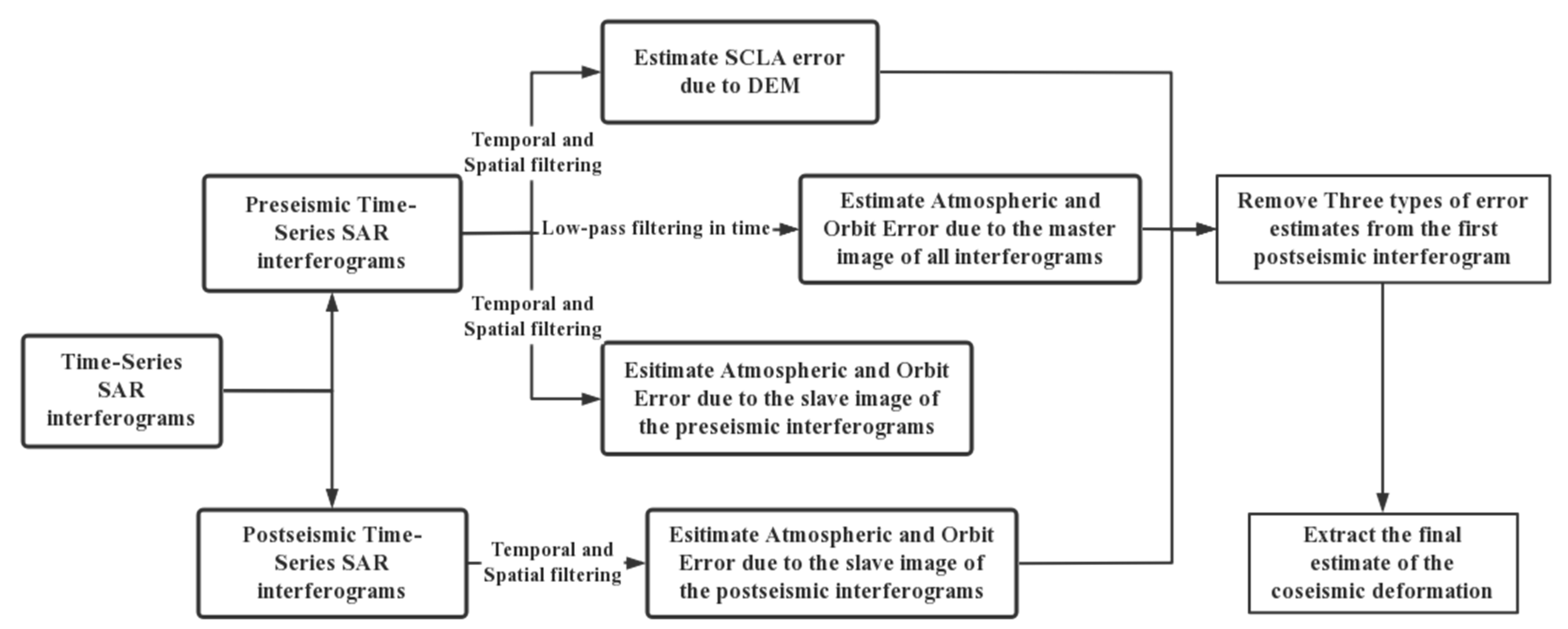

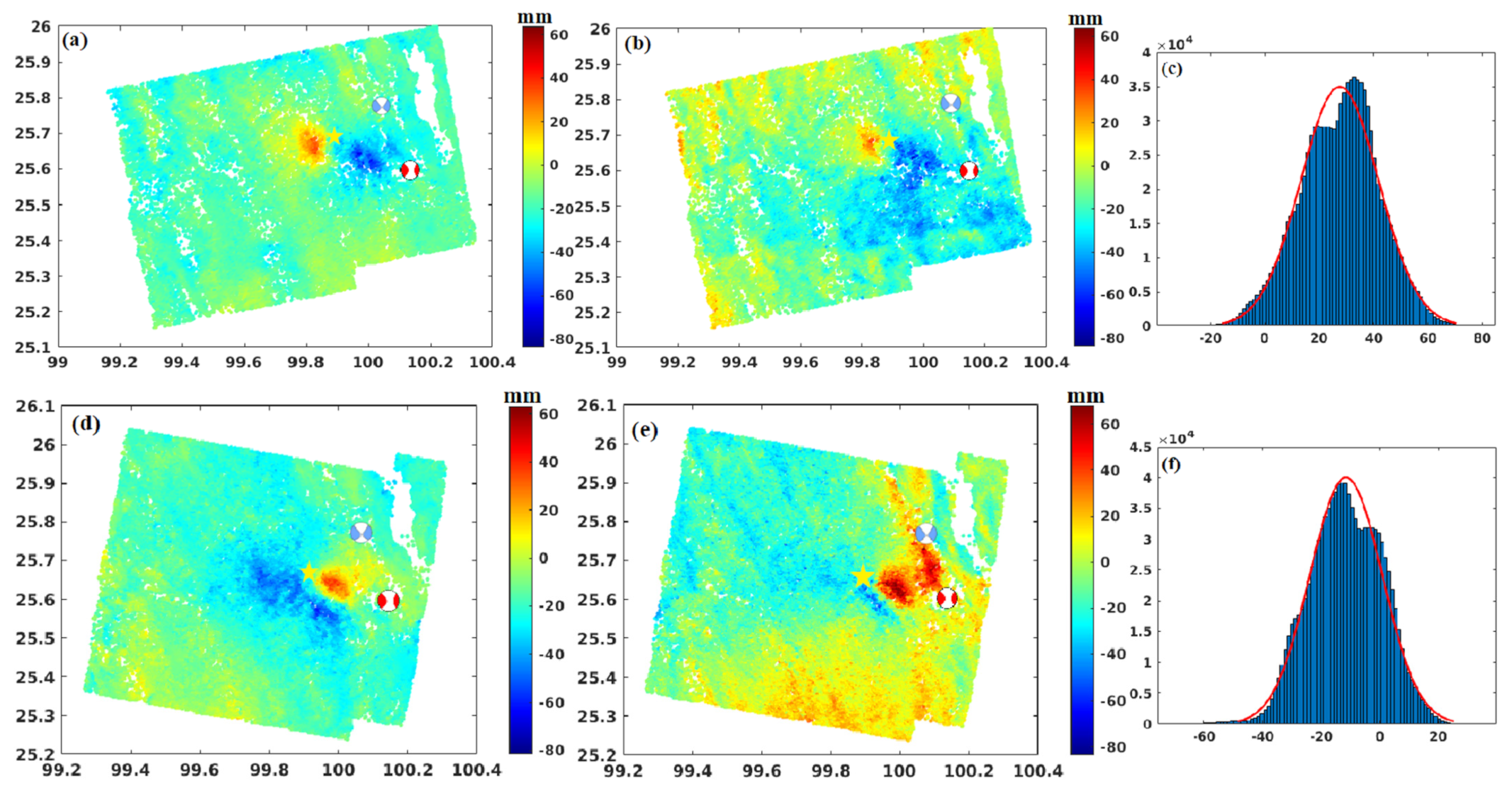

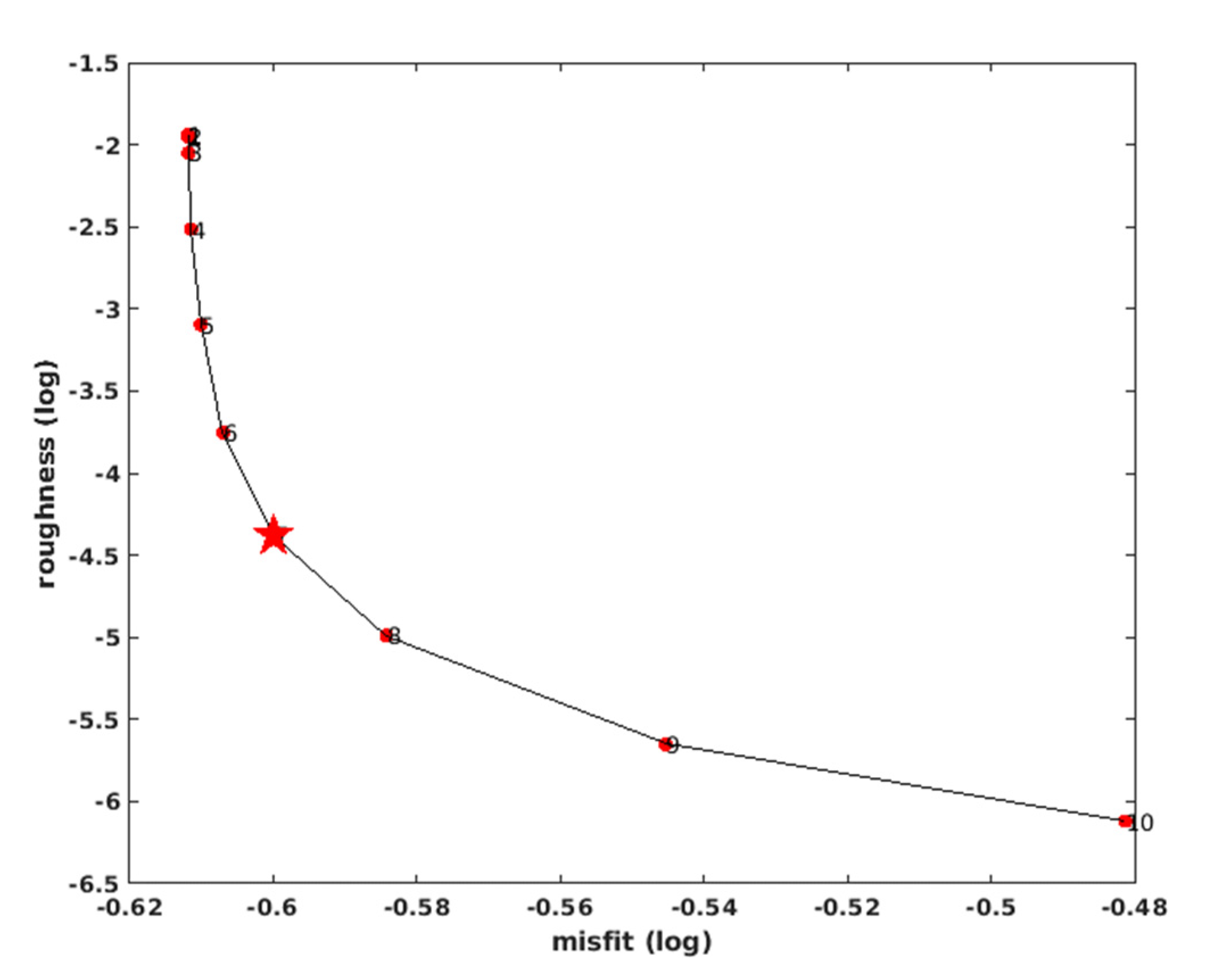

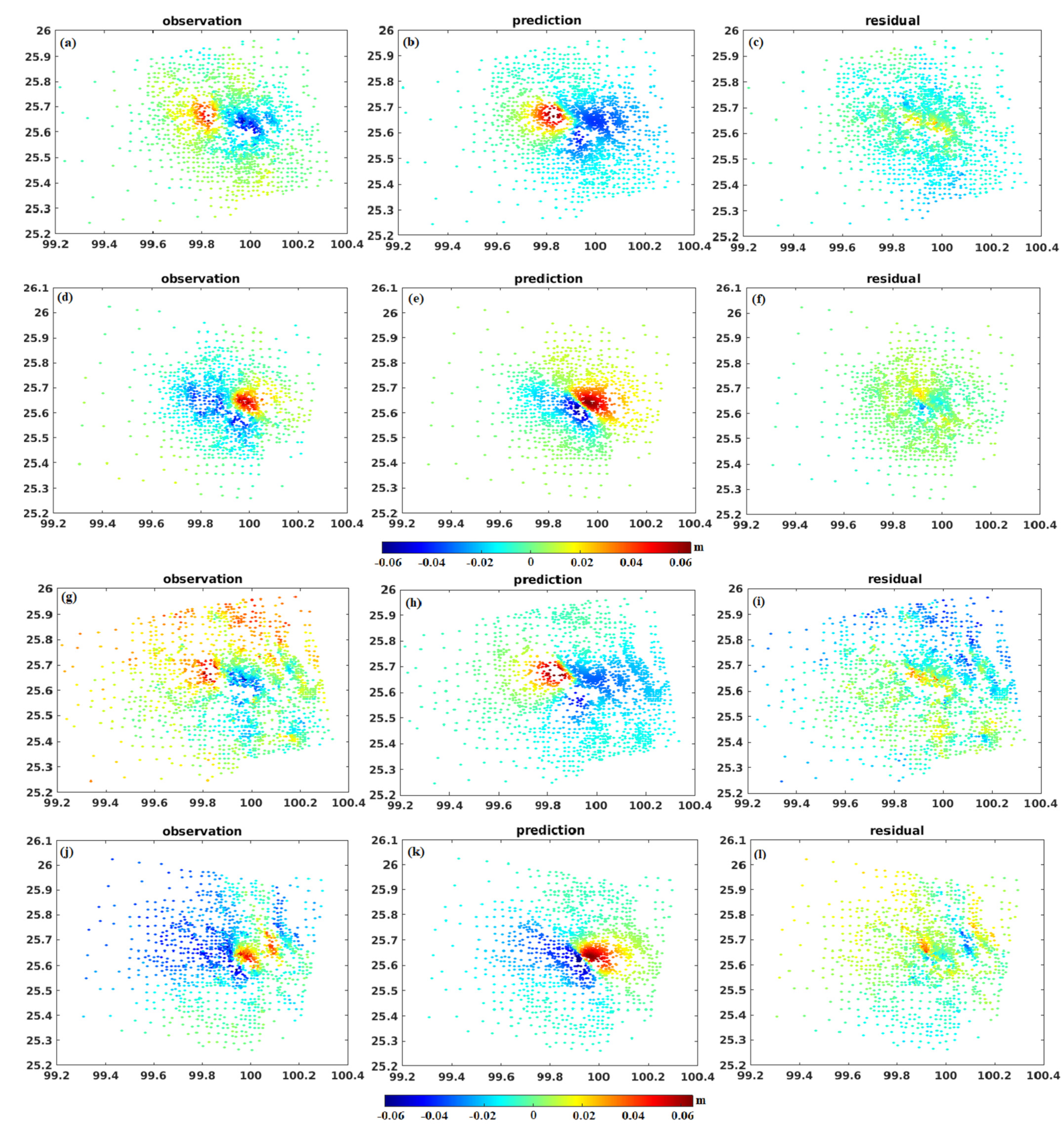

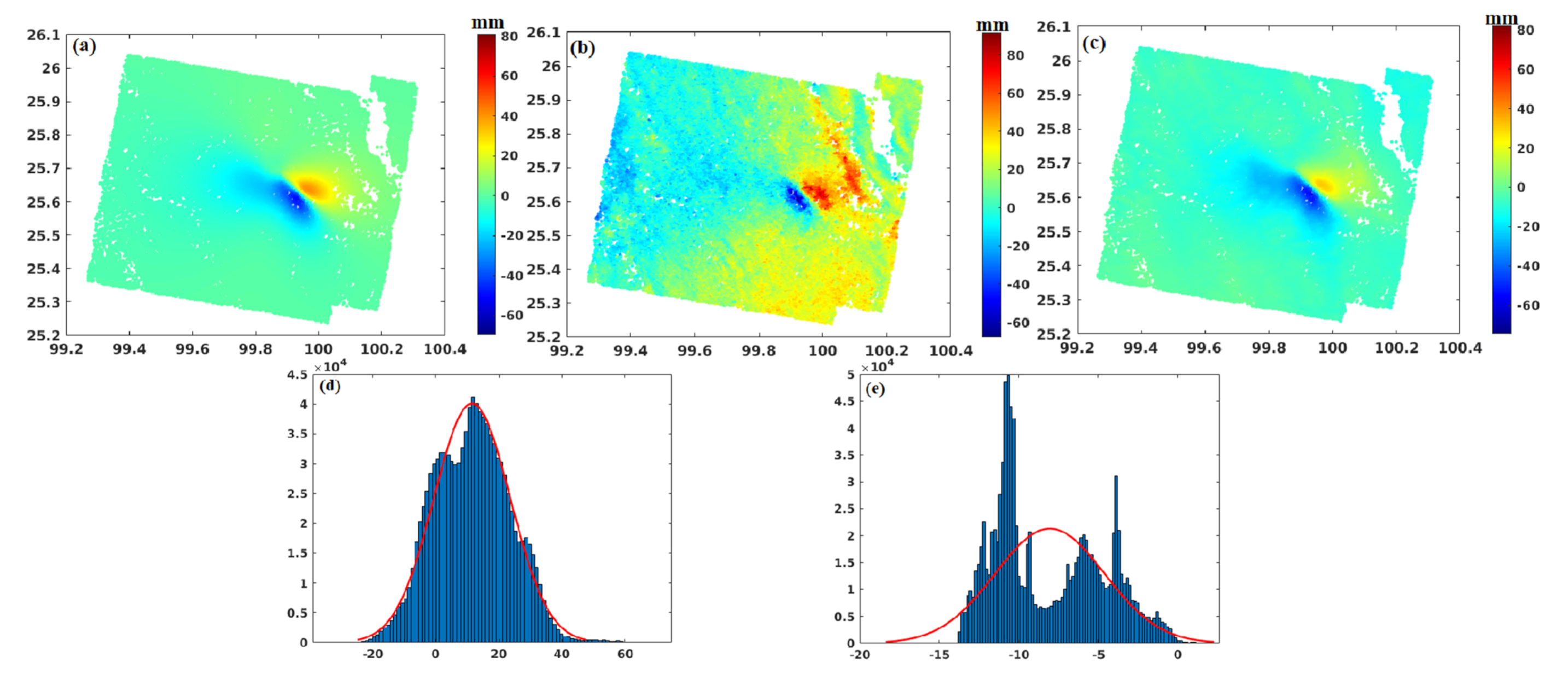
| Source | Epicenter | MW | Depth | Nodal Plane I | Nodal Plane II | |||||
|---|---|---|---|---|---|---|---|---|---|---|
| Lon | Lat | Strike | Dip | Rake | Strike | Dip | Rake | |||
| USGS | 100.008° E | 25.727° N | 6.1 | 17.5 | 45° | 89° | −5° | 135° | 85° | −179° |
| GCMT | 100.02° E | 25.61° N | 6.1 | 15 | 46° | 78° | 4° | 315° | 86° | 168° |
| Parameter | Optimal | Mean | Median | 2.50% | 97.50% |
|---|---|---|---|---|---|
| Length (m) | 17,233.9 | 17,295.8 | 17,275.5 | 15,465.8 | 19,263.9 |
| Width (m) | 1032.87 | 1332.03 | 1023.97 | 606.288 | 4089.61 |
| Depth (m) | 5498.51 | 5362.01 | 5411.48 | 4384.8 | 5931.69 |
| Dip (°) | 76.9801 | 78.2016 | 77.7524 | 83.8792 | 75.131 |
| Strike (°) | 133.428 | 133.559 | 133.544 | 130.624 | 136.601 |
| X center (m) | 9031.41 | 8813.28 | 8828.41 | 9525.23 | 8018.04 |
| Y center (m) | 10,176.4 | 10,319.8 | 10,264.8 | 10,928.8 | 10,011.5 |
| Strike slip (m) | 2.56309 | 2.48903 | 2.55033 | 0.685637 | 3.91905 |
| Dip slip (m) | 0.133527 | 0.123478 | 0.112916 | 0.0114473 | 0.287731 |
Publisher’s Note: MDPI stays neutral with regard to jurisdictional claims in published maps and institutional affiliations. |
© 2022 by the authors. Licensee MDPI, Basel, Switzerland. This article is an open access article distributed under the terms and conditions of the Creative Commons Attribution (CC BY) license (https://creativecommons.org/licenses/by/4.0/).
Share and Cite
Li, X.; Wang, C.; Zhu, C.; Wang, S.; Li, W.; Wang, L.; Zhu, W. Coseismic Deformation Field Extraction and Fault Slip Inversion of the 2021 Yangbi MW 6.1 Earthquake, Yunnan Province, Based on Time-Series InSAR. Remote Sens. 2022, 14, 1017. https://doi.org/10.3390/rs14041017
Li X, Wang C, Zhu C, Wang S, Li W, Wang L, Zhu W. Coseismic Deformation Field Extraction and Fault Slip Inversion of the 2021 Yangbi MW 6.1 Earthquake, Yunnan Province, Based on Time-Series InSAR. Remote Sensing. 2022; 14(4):1017. https://doi.org/10.3390/rs14041017
Chicago/Turabian StyleLi, Xue, Chisheng Wang, Chuanhua Zhu, Shuying Wang, Weidong Li, Leyang Wang, and Wu Zhu. 2022. "Coseismic Deformation Field Extraction and Fault Slip Inversion of the 2021 Yangbi MW 6.1 Earthquake, Yunnan Province, Based on Time-Series InSAR" Remote Sensing 14, no. 4: 1017. https://doi.org/10.3390/rs14041017
APA StyleLi, X., Wang, C., Zhu, C., Wang, S., Li, W., Wang, L., & Zhu, W. (2022). Coseismic Deformation Field Extraction and Fault Slip Inversion of the 2021 Yangbi MW 6.1 Earthquake, Yunnan Province, Based on Time-Series InSAR. Remote Sensing, 14(4), 1017. https://doi.org/10.3390/rs14041017








